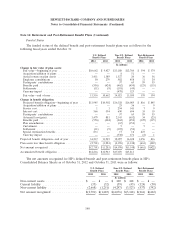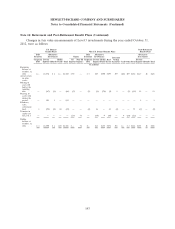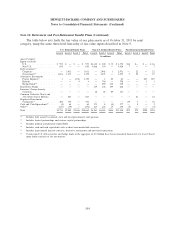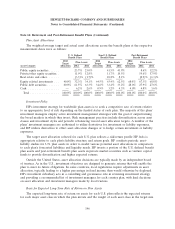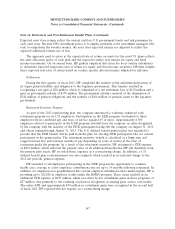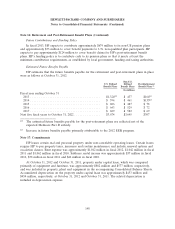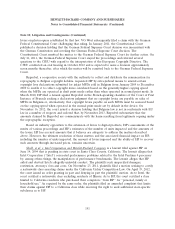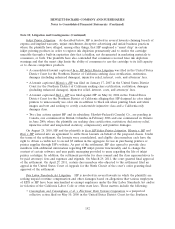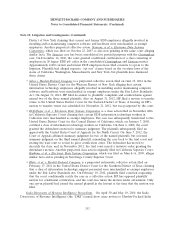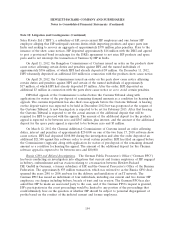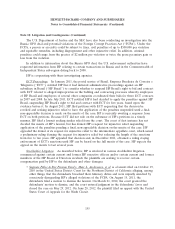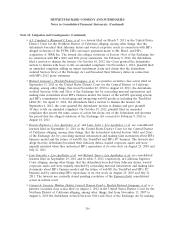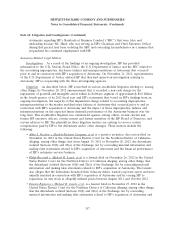HP 2012 Annual Report Download - page 155
Download and view the complete annual report
Please find page 155 of the 2012 HP annual report below. You can navigate through the pages in the report by either clicking on the pages listed below, or by using the keyword search tool below to find specific information within the annual report.HEWLETT-PACKARD COMPANY AND SUBSIDIARIES
Notes to Consolidated Financial Statements (Continued)
Note 16: Retirement and Post-Retirement Benefit Plans (Continued)
Expected asset class returns reflect the current yield on U.S. government bonds and risk premiums for
each asset class. Because HP’s investment policy is to employ primarily active investment managers who
seek to outperform the broader market, the asset class expected returns are adjusted to reflect the
expected additional returns net of fees.
The approach used to arrive at the expected rate of return on assets for the non-U.S. plans reflects
the asset allocation policy of each plan and the expected country real returns for equity and fixed
income investments. On an annual basis, HP gathers empirical data from the local country subsidiaries
to determine expected long-term rates of return for equity and fixed income securities. HP then weights
these expected real rates of return based on country specific allocation mixes adjusted for inflation.
Settlements
During the first quarter of fiscal 2012, HP completed the transfer of the substitutional portion of
its Japan pension liability and obligation to the Japanese government. This transfer resulted in
recognizing a net gain of $28 million, which is comprised of a net settlement loss of $150 million and a
gain on government subsidy of $178 million. The government subsidy consisted of the elimination of
$344 million of pension obligations and the transfer of $166 million of pension assets to the Japanese
government.
Retirement Incentive Program
As part of the 2012 restructuring plan, the company announced a voluntary enhanced early
retirement program for its U.S employees. Participation in the EER program was limited to those
employees whose combined age and years of service equaled 65 or more. Approximately 8,500
employees elected to participate in the EER program and will leave the company on dates designated
by the company with the majority of the EER participants having left the company on August 31, 2012
and others exiting through August 31, 2013. The U.S. defined benefit pension plan was amended to
provide that the EER benefit will be paid from the plan for electing EER participants who are current
participants in the pension plan. The retirement incentive benefit is calculated as a lump sum and
ranges between five and fourteen months of pay depending on years of service at the time of
retirement under the program. As a result of this retirement incentive, HP recognized a STB expense
of $833 million, which reflected the present value of all additional benefits that HP will distribute from
the pension plan assets. HP recorded these expenses as a restructuring charge. In addition, a U.S.
defined benefit plan re-measurement was also required, which resulted in no material change to the
2012 net periodic pension expense.
HP extended to all employees participating in the EER program the opportunity to continue
health care coverage at active employee contribution rates for up to 24 months following retirement. In
addition, for employees not grandfathered into certain employer-subsidized retiree medical plans, HP is
providing up to $12,000 in employer credits under the RMSA program. These items resulted in an
additional STB expense of $227 million, which was offset by net curtailment gains in those programs of
$37 million, due primarily to the resulting accelerated recognition of existing prior service cost/credits.
The entire STB and approximately $30 million in curtailment gains were recognized in the second half
of fiscal 2012. HP reported this net expense as a restructuring charge.
147





